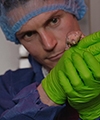Editor’s note: This seminar is the latest event in a series of seminars launched in May 2020 to help keep the pain research community connected during the COVID-19 pandemic and to provide all members of our community with virtual educational opportunities. The seminar series is supported by The MAYDAY Fund and the Center for Advanced Pain Studies at the University of Texas at Dallas, US.

The IASP Pain Research Forum hosted a seminar with Ewan St. John Smith, PhD, University of Cambridge, UK, on Tuesday, April 13, 2021, noon-1 p.m. Eastern Daylight Time (US)/5-6 p.m. BST/6-7 p.m. CEST. A Q&A session moderated by Thomas Park, PhD, University of Illinois at Chicago, US, followed the presentation.
A recording of the seminar is now available on the IASP Pain Education Resource Center here.
Here is an abstract of the talk
The naked mole-rat (Heterocephalus glaber) is a eusocial, subterranean mammal that is poikilothermic and lives in excess of 30 years. In the last 20 years, there has been great interest in the naked mole-rat as a model organism across a range of biomedical research fields owing to their cancer resistance, healthy aging, and unusual nociception. By discovering what underpins the extremophile nature of naked mole-rat biology, we hope to understand more about normal physiology. With regard to nociception, initial observations showed that naked mole-rats lack certain neuropeptides in their cutaneous afferents, and that they have a lower number of unmyelinated nerve fibers innervating the skin than most other mammals. Behaviorally, we found that naked mole-rats show no nocifensive response to capsaicin or acid, nor do they develop thermal hyperalgesia in response to nerve growth factor, and yet they display normal nocifensive responses to noxious pressure and heat. We have been able to determine both the molecules and neurocircuitry that underpin these changes, and believe that the naked mole-rat serves as a good model organism for studying the evolution of nociception, as well as demonstrating how studying extreme biology provides an alternative avenue for furthering our understanding of pain.
About the presenter
Ewan St. John Smith, PhD, completed his undergraduate degree in pharmacology at the University of Bath, followed by a PhD with Peter McNaughton at the University of Cambridge working on acid-sensing ion channels. He then moved to work with Gary Lewin at the Max-Delbrück Centre in Berlin as an Alexander von Humboldt Research Fellow, where he began working on pain peculiarities of the naked mole-rat. This was followed by a one-year stint with Niels Ringstad at the Skirball Institute of Biomolecular Medicine at NYU as a Max Kade Foundation Fellow, where he worked on CO2-sensing in C. elegans. In 2013 he was appointed to a lectureship in pharmacology at the University of Cambridge, where his research group focuses on understanding the molecular basis of nociception using both mice and naked mole-rats as model systems, as well as investigating the cancer resistance and healthy aging of naked mole-rats. He was promoted to senior lecturer in 2017 and reader in 2019, also being a fellow of Corpus Christi College where he is director of Studies in Biological Natural Sciences. Work in the Smith lab is currently funded by the BBSRC, Versus Arthritis, Dunhill Medical Trust, Astra Zeneca, Beiersdorf, and GSK.
About the moderator
Thomas Park, PhD, is a professor of biological sciences and neuroscience at the University of Illinois at Chicago. His graduate training was in sound perception in birds and gerbils. His postdoctoral training was in electrophysiology of auditory brain regions in awake bats. After taking a position at the University of Illinois at Chicago, he obtained a colony of naked mole-rats from Professor Jenny Jarvis with the idea of studying their hearing. But the extraordinary biology of this species expanded his research focus. Now, in addition to hearing, he focuses on amazing adaptations that naked mole-rats have for tolerating oxygen deprivation and high concentrations of carbon dioxide.
Join the conversation about the seminar on Twitter @PainResForum #PRFSeminar
We thank The MAYDAY Fund, and the Center for Advanced Pain Studies at the University of Texas at Dallas, US, for their support of the PRF seminar series.




